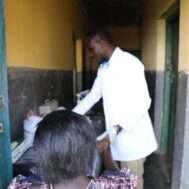Given the state of Uganda today, it is urgent that humanity and nature exist in balance. The burden, of course, is on the people to make this happen. In a country of 42.9 million people that could grow to 100 million by 2050, we are making this more difficult.
It doesn’t have to be that way. We know what must be done, but we must find the political and societal/cultural will to make it happen, in a manner that supports having a proper conversation about the best approaches. The solutions to attaining a healthy population count are grounded in the principles of rights and empowerment and are things the world should be doing anyway.
One of the first things to do is to invest in young people, who make up more than 75% of Uganda’s population and a population of 24 million women in health, particularly by providing deliberate and voluntary family planning services. This is often referred to as “low-hanging fruit,” because it is the right thing to do, relatively simple to provide, and something that most women and men desire. Everyone should have the right to plan if and when to have a family, and have the tools, resources, and access to do so, or not do so.
There are more than 23.19 million women in Uganda, including 10 million that are of reproductive age, but 17% want to delay or avoid pregnancy but are not using a modern contraceptive method. It is also true that 46 percent of Uganda’s estimated 36 births per thousand pregnancies in 2020 were unintended (PMA,2020).
The estimated current annual cost of providing modern contraceptive services in Uganda has gaps, including direct and indirect costs.
According to the National Family Planning (FP) Cost Implementation Plan (CIP) II (2021/22–2024/25), the overall funding need for FP commodities is the US $332.3 million. The government’s overall commitment to the reproductive health (RH) supplies budget over this time period, however, is the US $ 25 million. If this were to be expanded and improved to address all men and women’s needs for modern contraception in Uganda, a funding gap of US $ 307.3 million needs to be avoided.
Just to put that in perspective, the total per capita consumption of pure alcohol is 23.7 liters in Uganda. This approximately accounts for 480,000 shillings spent on alcohol by each Ugandan.
The government allocated a total of UGX 3.722 trillion for healthcare delivery in the financial year (FY) 2022/23. This has been largely geared towards the COVID-19 vaccination.
The good news is that with the celebration of 13 years of the Advance Family Planning initiative (AFP) in Uganda, the citizens know what to do, how to do it, and why to do it concerning family planning access. Let’s look at just two examples of why investing in family planning can make a huge difference in people’s lives in Uganda.
Most of the districts in Uganda are experiencing the highest rates of population growth in the world. In fact, Uganda’s population is expected to double, from 42.9 million today to 100 million by 2050. (UBOS, 2020)
One of the country’s fastest-growing populations in Wakiso. Its current population of 2.9 million is projected to reach 5.1 million by 2050, and it is one of Uganda’s youngest and most urbanized districts, with over 88 percent of the population under the age of 30. The district also has a number of street children and destitute.
One in four girls between the ages of 15 and 19 in Uganda has given birth or is carrying her first child, according to the United Nations Population Fund (UNFPA) country’s 2020 report. Reducing teen pregnancies will result in greater education and economic opportunities for young people. Meeting the reproductive rights and needs of youth through education, outreach, and access to services is imperative. Local organizations such as Reproductive Health Uganda and partners are working with youth to raise awareness and access to contraceptives and family planning services.
Unplanned teenage pregnancies account for 25% of all pregnancies in Uganda (PMA, 2020). The district of Iganga worked to change this situation through the Iganga Family Planning Initiative, which provided training, support, and low-or no-cost long-acting reversible contraceptives (LARCs) to low-income women, especially teens through the AFP and other interventions.
The Iganga district made more progress than any other district in using family planning to reduce unplanned pregnancies (UBOS, UNFPA, 2020). The district department of Health reported that teen pregnancies were nearly cut in half and that, ” the AFP initiative and other interventions empowered thousands of Iganga women to choose when and whether to start a family” Iganga’s experience is a model for other districts. They can now educate, treat and do other development activities with fewer, but manageable family sizes. If replicated, with fewer resources required to manage families, the surplus can go to agriculture, and business and help achieve Uganda’s national development plan III and vision 2040 indicators.
As we celebrate this year’s World Contraceptive Day on September 26, 2022, let’s focus on family planning as a development issue; make it visible; budget for it; and make policies that allow for its access in Uganda. It is good for the child, mother, father, and family.
The author of this opinion story Aldon Walukamba is a Media Advocacy and Documentation Coordinator at RHU



